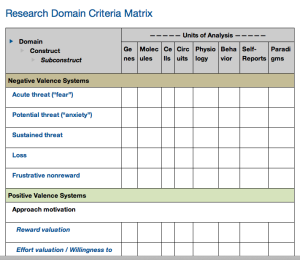In 2013, Tom Insel, Director of the US funding agency, National Institute of Mental Health (NIMH), created a stir with a blogpost in which he criticised the DSM5 and laid out the vision of a new Research Domain Criteria (RDoC) project. This aimed “to transform diagnosis by incorporating genetics, imaging, cognitive science, and other levels of information to lay the foundation for a new classification system.”
He drew parallels with physical medicine, where diagnosis is not made purely on the basis of symptoms, but also uses measures of underlying physiological function that help distinguish between conditions and indicate the most appropriate treatment. This, he argued, should be the goal of psychiatry, to go beyond presenting symptoms to underlying causes, reconceptualising disorders in terms of neural systems.
BishopBlog objects to the whole paradigm:
The RDoC program embodies a mistaken belief that neuroscientific research is inherently better than psychological research because it deals with primary causes…
From the RDoC:
Imagine treating all chest pain as a single syndrome without the advantage of EKG, imaging, and plasma enzymes. In the diagnosis of mental disorders when all we had were subjective complaints (cf. chest pain), a diagnostic system limited to clinical presentation could confer reliability and consistency but not validity. To date, there has been general consensus that the science is not yet well enough developed to permit neuroscience-based classification. However, at some point, it is necessary to instantiate such approaches if the field is ever to reach the point where advances in genomics, pathophysiology, and behavioral science can inform diagnosis in a meaningful way. RDoC represents the beginning of such a long-term project.
Second, RDoC is agnostic about current disorder categories. The intent is to generate classifications stemming from basic behavioral neuroscience. Rather than starting with an illness definition and seeking its neurobiological underpinnings, RDoC begins with current understandings of behavior-brain relationships and links them to clinical phenomena.
“Constructs,” i.e., a concept summarizing data about a specified functional dimension of behavior (and implementing genes and circuits) that is subject to continual refinement with advances in science. Constructs represent the fundamental unit of analysis in this system, and it is anticipated that most studies would focus on one construct (or perhaps compare two constructs on relevant measures). Related constructs are grouped into major domains of functioning, reflecting contemporary thinking about major aspects of motivation, cognition, and social behavior; the five domains are Negative Valence Systems (i.e., systems for aversive motivation), Positive Valence Systems, Cognitive Systems, Systems for Social Processes, and Arousal/Regulatory Systems.
Here’s a matrix to illustrate what he’s got in mind:

The columns of the matrix represent different classes of variables (or units of analysis) used to study the domains/constructs. Seven such classes have been specified; these are genes, molecules, cells, neural circuits, physiology (e.g. cortisol, heart rate, startle reflex), behaviors, and self-reports.
In addition, since constructs are typically studied in the context of particular scientific paradigms, a column for “paradigms” has been added; obviously, however, paradigms do not represent units of analysis.
It may be that BishopBlog objects to Insel’s ideas because BishopBlog is more optimistic and less derogatory with respect to psychological intervention. After all, Insel admitted that “a diagnostic system limited to clinical presentation could confer reliability and consistency but not validity.” But what more do you need besides reliability and consistency to treat patients?





